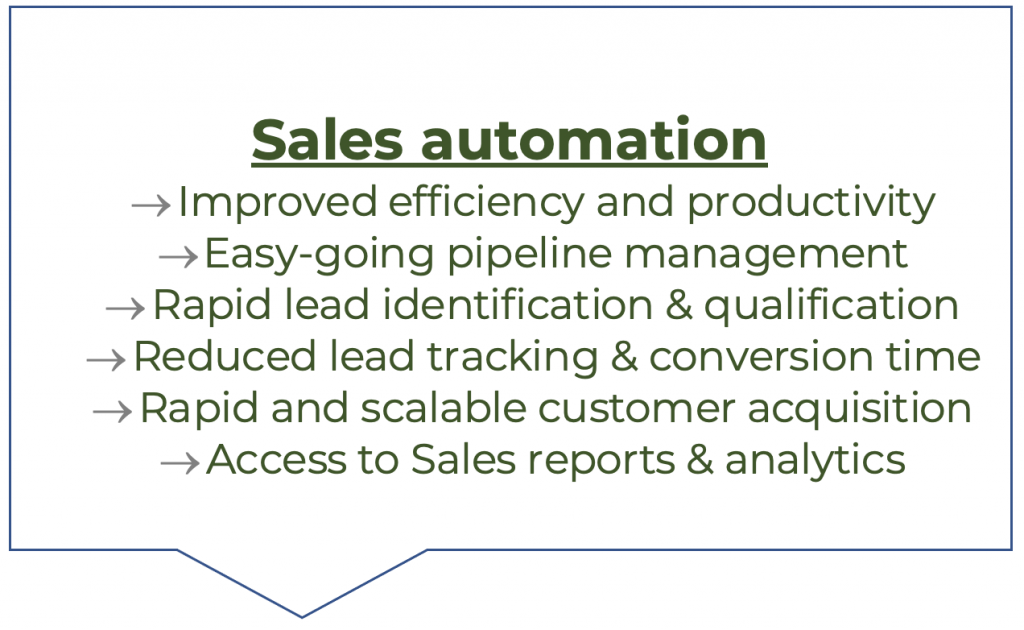What is sales automation and why it’s mandatory to drive growth?

From lead generation through ongoing client support, sales automation covers the digitization and automation of sales activities. B2B companies are slowly but rapidly recognizing the need to put the client at the center of their processes, which forces them to engage themselves more and more in the digital environment. In 2021, nearly 61% of companies that used automation exceeded their revenue targets — demonstrating the potential of sales automation. Yet very few people are aware of the tremendous benefits this provides, especially for sales. Here below are few statements that holds the power to persuade sales managers why they must start with sales automation asap.
- Sales automation is a form of data collector that continuously and automatically gathers the data related to the sales. The sale and purchase experience of a potential client can be improved with each of his recoded activities by using lead scoring to automatically capture and evaluate customer interactions at numerous touchpoints. With the aid of seamless data synchronization in real time, a very detailed profile is immediately generated from this data and can also be mapped directly in the CRM system. Additionally, sales automation aids in determining when and which touchpoints of the customer’s journey are controlled by him.
- Sales automation gathers a staggering amount of insightful data. As a result, salespeople are better equipped to take into account the preferences and wants of the target market and make smart sales decisions based on reliable data in the CRM system rather than just on intuition. Thus, sales automation becomes the backbone for launching customer-focused sales initiatives and a crucial success element for B2B enterprises’ digital sales.
- Professional sales automation enables potential clients to be identified at the beginning of their customer journey and then effectively and efficiently followed and developed. As a result, not only the number of qualified leads increases but also the quality of lead grows. Deals are closed with significantly less effort and at the same time with a higher probability. Additionally, sales automation makes sure that they never miss a chance to close a deal because they are always automatically informed of what their clients are doing, whether it be by email or the CRM system.
- Lead conversion is ensured with a transparent and reliable information from the acquisition phase. Sales teams can create offers and talks more independently, which greatly decreases the amount of coordination and negotiation loops by shortening the sales cycle. Even with cross- and upselling campaigns, it is possible to segment customers in a targeted manner and only launch offers or campaigns to contacts for whom the end result is guaranteed. Sales Automation, such as, templates, personalization tools, and segmentation possibilities not only speeds up repetitive operations, like making email lists or tracking offers, but also improves the quality of the outcomes.
- The presence of incorrect data or missing customer information in CRM system can be a big obstacle for sale teams. Through real-time synchronization between the marketing automation and CRM system, for instance, sales automation helps to reduce the risk of errors in this situation. All data is updated simultaneously via bidirectional synchronization, regardless of whether it is data entry, updating and enriching client data, or maintaining a complete database. It is also possible to automatically check for and repair duplicates, incomplete data records, and invalid address entries. As a result, every department that interacts with customers has a consistent and up-to-date.
Sales are becoming more automated and digitalized, which boosts sales potential in a targeted way and can support the company’s growth. Additionally, Sales Automation provides several opportunities for expansion that is quick, effective, and seamless. Companies should therefore not wait any longer to digitize and automate their processes – the competition may already be doing it. Only those who act quickly and take their processes to the next level can be one step ahead of the competition.
